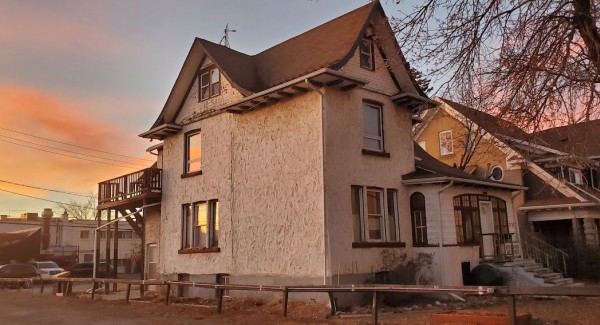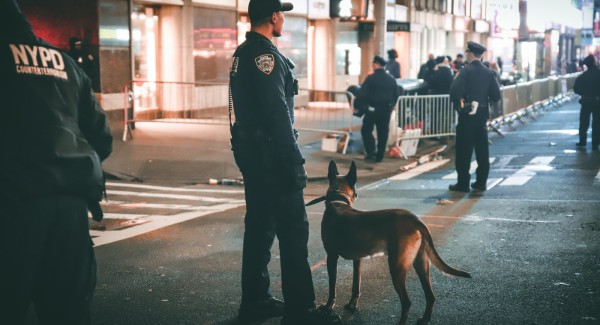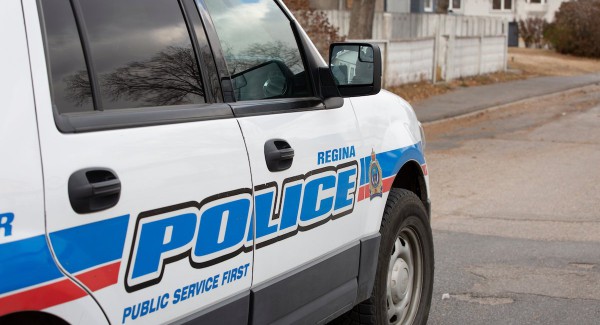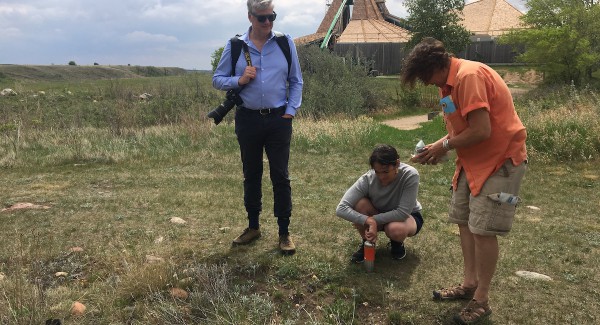Feeding a neighbourhood
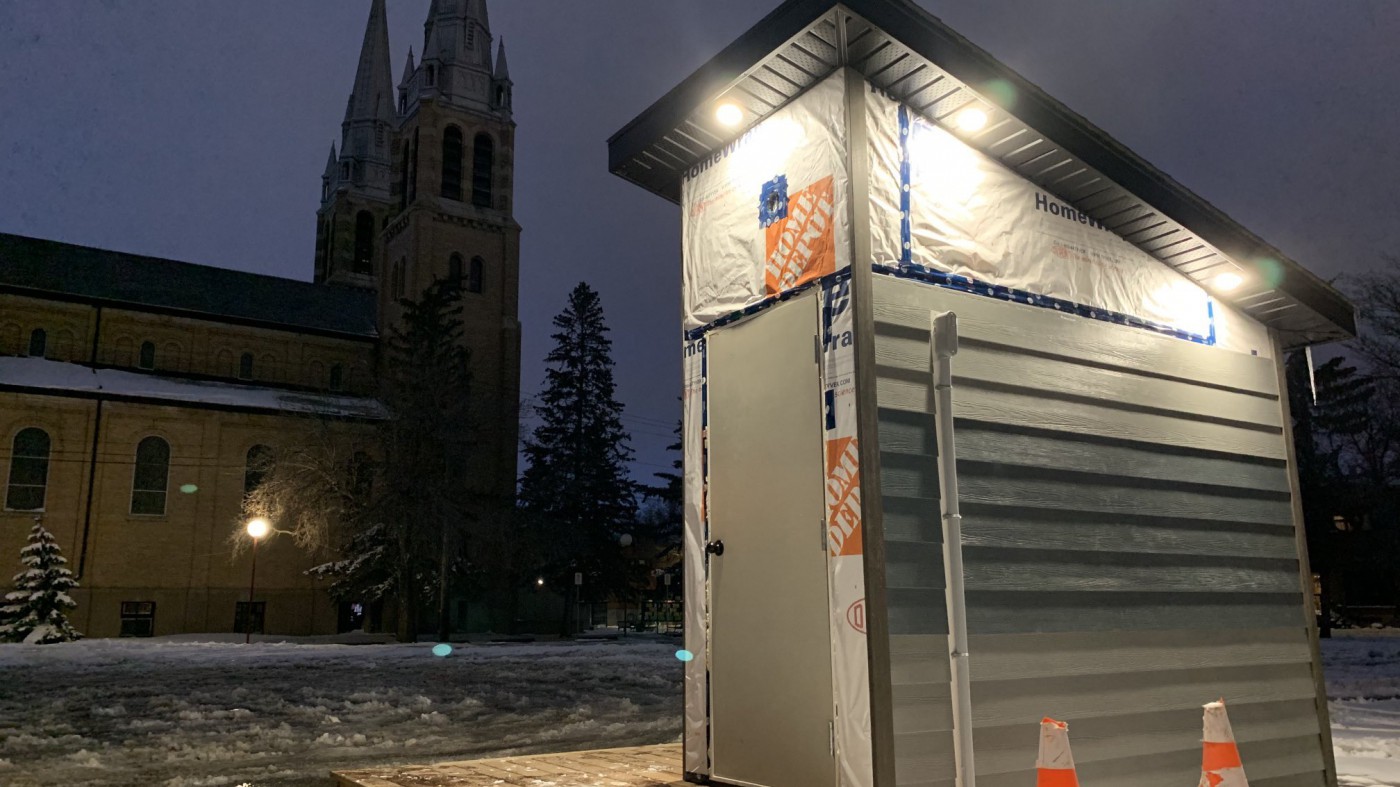
Photo via Wayne Mantyka/Twitter.
On an unseasonably warm Monday morning in early fall, I meet Brianna Kroener in the parking lot of the Holy Rosary Cathedral in Regina. We’re next to the Cathedral neighbourhood’s community fridge, and I’m joining her on her morning pickups. Four days a week – Monday to Thursday – she and other volunteers take turns driving out to pick up food in bulk that would otherwise be discarded.
The fridge opened in April 2021 and is the second of four to be built in the city – stocked with everything from lettuce to tampons, anyone in need can take items from the shed-like structure, 24 hours a day, no questions asked. Although Kroener isn’t one to support hierarchical leadership structures, her ability to coordinate, make connections, think on her feet, and talk to just about anyone have made her a de facto leader at the fridge. Kroener is the kind of person you can call on when a crisis arises, and whom you can trust to get a message across to media.
Kroener tells me the bulk distributor, where we’re heading, prefers to keep its association with the fridge anonymous, since the fridge is not a registered charity. The fridge and the distributor make strange bedfellows. “At the very beginning I really pushed against asking for any support of corporate or large businesses because I wanted to prove the fact that we could do it without them,” Kroener says. But the connection means that food that would otherwise go in a dumpster gets to the people who need it. Although the food they get is always good quality and never expired, they have no say in – or warning about – what they might be picking up.
The fridge opened in April 2021 and is the second of four to be built in the city – stocked with everything from lettuce to tampons, anyone in need can take items from the shed-like structure, 24 hours a day, no questions asked
As we pull up in front of the loading door, Kroener, who is wearing a Skinheads Against Racial Prejudice T-shirt and black lace-up boots, tells me I’m going to meet Ken. “Ken is fucking spectacular,” she says.
She’s talking about Ken Ketchur, fridge user turned volunteer. He comes out with a pickup covered by a topper to help load up whatever food the distributor is giving. Ketchur began using the fridge early in the pandemic, but he was initially reluctant to access the resource. “It’s not supposed to be that way,” Kroener says. “But you’ve been conditioned to feel bad about needing things.” She says she asked him to volunteer, so that using the fridge “would make sense to his working mind.” It’s clear once the food comes out – a cardboard crate four feet deep and four feet across, heaped with 10-pound bags of red potatoes – that this operation couldn’t happen without Ketchur, as there’s no way the food would fit in Kroener’s car.
“I’m always thinking about logistics,” she tells me as we load the potatoes into the back of Ketchur’s truck. Once, they had 200 pounds of bananas that Kroener and others turned into baked goods using the borrowed kitchen of a local church. Another time, they ended up with a huge crate full of dairy products that they had to distribute before they spoiled.
Kroener says that the local food bank sends trucks out here to pick up food five times a day. Food banks are a source of frustration for her – the organizations suck up food and funding in communities while gatekeeping who gets help. At the Regina food bank, users have to provide their name, phone number, birth date, and identification for every member of their household – including roommates and children – before they can access a food hamper. If they do not have proof of address – for example, a lease agreement or a bill with their name and address – they are limited to one emergency hamper. They must come with proof of address for any additional food support. The food bank is also only open from 9 a.m. to 11:30 a.m. and 1 p.m. to 3:30 p.m. Monday to Friday, and it’s located in the city’s industrial area, a long trip from downtown. The result is a service that shuts out the people who most need food: those without an address or phone number, or those who fear their information will be passed on to authorities, like undocumented people or people who may have a warrant. And at the end of the day, food banks do almost nothing to change the conditions of enforced poverty that keep people hungry. To Kroener, food banks embody a controlling and holier-than-thou charity mentality – and her mantra is “solidarity, not charity.”
Once, they had 200 pounds of bananas that Kroener and others turned into baked goods using the borrowed kitchen of a local church. Another time, they ended up with a huge crate full of dairy products that they had to distribute before they spoiled.
As we load potatoes, Kroener and Ketchur talk about the people who are a part of their informal mutual aid community. “It’s Joe’s birthday,” Kroener tells Ketchur. She adds that Dave, a fridge regular who Kroener describes as both “rough” and “spectacular,” has gone back east to be with his mother, who is sick, maybe dying. “It’s so good he’s going back to see her,” Kroener says. Ketchur, who regularly grabs food for his own mother, who has macular degeneration, agrees. They’ve known Dave long enough to know that he’s been talking about going to see his mom for a long time.
When the bags have been loaded – any potatoes that have fallen from broken bags are left behind – Kroener and I strip off our safety vests and get back in her car, trailing Ketchur back to the fridge. On days like this, when there’s a truckload of things to unload, the two of them often do rounds, unloading at Cathedral’s fridge, then North Central’s, then Heritage’s. Now that the University of Regina has a community fridge of its own, it’s become a part of the rotation as well.
While she’s glad people aren’t going hungry, Kroener says, “there’s no joy in this for me. I don’t want to be doing this shit.” She gets frustrated when reporters ask her if it feels good to do this work. “No, it doesn’t feel good,” she says. “It fucking sucks. It sucks that we have to do this. And that’s why I tell people, ‘solidarity, not charity.’ Because if charity worked, we wouldn’t need it anymore.”
That’s why she pushes back against community members who suggest getting charitable status for the fridge. “They ask, ‘Why don’t we get charitable status? Why don’t we go for government grants?’ And it’s difficult explaining that we can’t fix the failures within the system by operating within the system that brought the failures. You can’t utilize a broken system to fix a broken system. It’s literally built to continue failing us.”
She lights a cigarette. “I don’t feel like dancing with the devil when we’re trying to make him go away.”
Photo via Holy Rosary Community School/Twitter.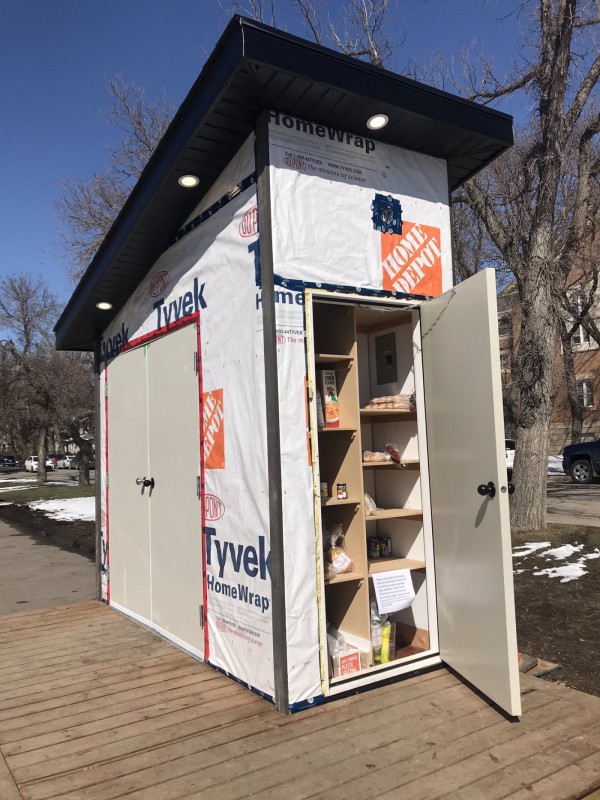
When we pull up in front of the Cathedral fridge a few minutes later, there are already a dozen or more people milling around outside, along with those who are waiting in their vehicles. Most of the people waiting are middle-aged or older – a scenario we’ll see repeated when we stop at the fridges in North Central and in Heritage. Joe, a slight, middle-aged man with short black hair, is already there and Kroener tells him she’s got a birthday cake for him for later (“we’ll use a cigarette as a candle” she says). While she assesses the dry storage portion of the fridge, trying to see how much space there is for the potatoes, other fridge regulars wish him a happy birthday and tease him, asking him if it’s his sweet 16.
Kroener says it’s important that people feel like they’re a part of the fridge’s operations. While Ketchur opens up the back of the truck, Kroener asks some of the people waiting to form a chain and pass bags of potatoes into the fridge. “We consider them in everything we do,” she says. “That’s why it’s so important to get to know your community, to ask their consent before you bring anything in instead of being like, ‘Here’s this resource, hope you use it, you poors.’”
Before the fridge was set up, Kroener and others went door knocking, asking people who lived in and around the area if a fridge was something they even wanted in their community. “If you’re not reaching out to the neighbourhood and asking their consent to have this, or asking if they need it, or asking if they want to participate in it, you’re going to have negativity surrounding the fridge. You’re going to have people pushing back on it.” And, she says, “a lot of people really enjoy it. Local businesses love it. People in the area love it. The only people who really don’t like it are the large corporate chains, just because they think that it’s stealing business from them, but they don’t really think about the people who wouldn’t be spending money there in the first place because they don’t have money to spend.
“It fucking sucks. It sucks that we have to do this. And that’s why I tell people, ‘solidarity, not charity.’ Because if charity worked, we wouldn’t need it anymore.”
The fridge is located in the parking lot of the Holy Rosary Cathedral – a church not much younger than Regina itself. The Cathedral’s twin spires are iconic parts of Regina’s architecture, and the fridge itself is quickly becoming iconic in its own right.
Built by community members, it feeds around 150 people every week and sees a regular crew of around 20 to 25 volunteers, according to Kroener. But for many in the area, the fridge is more than just a place to grab food. It has become a site of struggle and a symbol of solidarity, a place where people can go when they’re hungry, be in community with one another, and even get a political education. The fridge’s website offers a “library” section where people can find mutual aid resources and tools, including crash courses on how to start your own mutual aid network, what an anarchist response to capitalist crisis looks like, and the differences between mutual aid and charity. For those without internet access, the fridge itself has leaflets stocked inside.
It’s fitting that there would be a community fridge in Cathedral, and it’s fitting that it would take on a ferocious political mandate. Cathedral is one of the oldest neighbourhoods in Regina, separated from the city’s downtown by the north-south cut of Albert Street, and leftist politics are not new to the area. “There’s a real heritage there of some radical organizing,” says Patricia Elliott, a journalism professor who has lived in the neighbourhood since 1987.
In the ’70s, parents successfully lobbied for a community school designation and a universal school lunch program that has since been scrapped. Community schools are, in a way, emblematic of the kind of neighbourhood that mid-century Cathedral residents were trying to build. Publicly funded like other primary schools, community schools also function as a locus of community life, with after-school and evening programming for students and neighbourhood residents, school nutrition programs, and discretionary funding for extra costs, like day trips, arts programming, and other enrichment activities that don’t necessarily fall under the scope of the school curriculum. Although there are 134 community schools in the province as of 2014, at the time, it was a new and truly radical idea. “It was a time when school parents were not afraid to confront authority,” says Elliott, “and they worked really hard to create a sense of community connection and ownership.”
“If you’re not reaching out to the neighbourhood and asking their consent to have this, or asking if they need it, or asking if they want to participate in it, you’re going to have negativity surrounding the fridge. You’re going to have people pushing back on it.”
Bordered to the north by the city’s North Central neighbourhood – made infamous by a 2007 Maclean’s profile that unfairly dubbed it “Canada’s Worst Neighbourhood” – and to the south by Lakeview – a neighbourhood where homes may be priced at over a million dollars – it’s perhaps unsurprising that Cathedral is both the home of a radical political history and also the area of the city that is most likely to be accused of the crime of gentrification. Elliott says the neighbourhood has become less affordable as it has become trendier, adding that “if I didn’t already live here, I couldn’t afford to move here now.” As it became more expensive, some of the radical spirit ebbed away. “I saw the turn of that period [of radicalism], when things started getting a little bit more passive,” she says.
Unlike many other areas of Regina, which are sharply segregated along class lines, extreme poverty and extreme wealth live cheek by jowl here. Across the street from the fridge, which routinely has to put out calls for menstrual products and the kinds of non-food items that Kroener says “let people have some dignity,” a person can buy a pack of “Geisha Blotting Paper” for $18 or a set of false eyelashes for $30 at Blush Beauty Bar. Within sight of the fridge, which Kroener says “struggles” to source things like diapers and wipes, a person can buy three abstract wooden shapes that fit in another abstract wooden shape for $45 at Groovy Mama. Some homes in Cathedral have plaques out front, bearing the names of their original wealthy settler inhabitants. Meanwhile, not far from the fridge itself is a low-income seniors’ complex where residents subsist on meagre pensions and where one resident, whom Kroener has grown close to, is up at all hours cooking for everyone to keep her PTSD at bay. The visibility of the trendy shops and the neighbourhood’s tony reputation can often mask the economic insecurity that also exists here. “There can be a tendency for people to not think that there could be need in the neighbourhood,” says Elliott.
Kroener, who is a Red Seal chef by trade, has lived in the neighbourhood for about five years. She grew up splitting her time between Germany and Canada, and when she talks about her politics, she’s clear that she wasn’t always on the left. “I was very close to being a neo-Nazi,” she says. It was exposure to a political education that brought her around to a political viewpoint that could best be described as anarchism. She says her partner helped her “to understand a lot of really important anarchist principles and ways of operating that were really beneficial to the movement in general in order to get things off the ground and work within a system that doesn’t want you to help each other.”
For Kroener, community fridges are part of a broader strategy of “food outreach,” which can encompass anything from making meals for people who can’t leave their homes to providing nutrition information to families, to whatever else is necessary to ensure that no one in the community is going hungry.
Anarchism is a political ideology that is skeptical of authority and hierarchical government structures. Anarchists call for the abolition of the state, which they point out is often abusive, violent, and oppressive, particularly to certain out-groups. However, contrary to the media’s portrayal of anarchists as violent and destructive, the thought and practice of anarchism centres on mutual aid and non-coercive, non-hierarchical social structures that orient communities toward providing one another with the goods and services they need, without a middle person. In the early days of the pandemic, when it became clear both that many people would lose their jobs, their incomes, their child care, and even their homes, and that the state would be hard-pressed to respond to the growing catastrophe, anarchist philosophy and practice – whether it was explicitly labelled anarchist or not – began to flourish in the form of meal delivery services and community check ins, tenants’ unions, and, of course, community fridges.
For Kroener, community fridges are part of a broader strategy of “food outreach,” which can encompass anything from making meals for people who can’t leave their homes to providing nutrition information to families, to whatever else is necessary to ensure that no one in the community is going hungry. She first became involved with a different community fridge, the one on Dewdney Avenue in North Central. It opened in December 2020, making it the first in Regina. She witnessed what she considers the “mistakes” of that fridge, including not getting consent from the community to build it. When she had the idea for a fridge in Cathedral, she remembers, “I was like, ‘I’m going to get this one right. There’s no way I’m going to let this fail this early on.’”
Far from being a minor operation, the Cathedral fridge is a well-coordinated network of people working to keep the fridge filled as often as they can, with as much good food as possible, in a way that avoids getting tangled up in the politics and priorities of corporations and charities.
Avoiding those bureaucracies as much as possible is a stance worth taking – Elliott says that part of the decline of the Cathedral neighbourhood’s radicalism of four decades ago came when “the school-community councils that were their own incorporated non-profits got sucked into the education bureaucracy.” The system absorbs and neutralizes what it can.
“There can be a tendency for people to not think that there could be need in the neighbourhood,” says Elliott.
Talking to Kroener reveals a vast web of people who have little in common except for their desire to feed their communities and not see food wasted. She tells me about a woman from Moose Jaw whom she doesn’t know personally but who comes in to the distributor regularly to load her truck full of meat that’s not yet bad but is on its way to being destroyed.
“When a freezer goes down, instead of selling [its contents] at a discounted rate, the distributor puts it on a big truck and they send it to Calgary to incinerate it,” Kroener explains. “They’re spending that money to send a truck out there, and then they’re burning the meat. But before they do that, they call her and she’ll intercept it, and then she’ll call us.” Kroener says someone from the fridge will meet her “on the highway, and guerilla-style we’ll load that shit up and we’ll cook with it.”
Although the food is on its way to destruction, Kroener makes sure the food they use at the fridge is high quality. She says that while there’s no law that says they can’t give out inferior food, since they’re not a charity, she nonetheless refuses to take food that is expired. Nor will they distribute food to people if it isn’t culturally appropriate: for example, they won’t offer a two-kilogram bag of lentils to an elder who has no experience cooking with lentils, or send someone home with a can of pumpkin pie filling and nothing else, or hand a whole chicken to someone with no oven (or instructions) to roast it with. “It’s guerilla style,” she says. “But we have integrity.” The fridge is about ensuring people are fed, not just making sure they have access to food.
That’s part of the reason Kroener is excited to see new fridges pop up – and why she’s become so committed to the idea of creating a free store that can serve the needs of the community beyond just food and toiletries.
“It’s been so insane watching this network build,” she says. “Right now we’re looking for a building or somebody’s garage or something where we can operate kind of guerilla style for now where we can at least provide a hub where all the fridges can utilize the services. Quite often we get massive amounts of food that we just cannot distribute in one day and because of food safety we can’t be storing it for long amounts of time. So for food safety, we need one centralized area where everybody can come. If a fridge is empty, they can just come and pick up more.”
“It’s guerilla style,” she says. “But we have integrity.” The fridge is about ensuring people are fed, not just making sure they have access to food.
Like mutual aid, free stores are a form of constructive direct action. They allow people in communities to provide items like survival essentials, clothing, over-the-counter medications, menstrual products, linens, and books either for free or through barter, without requiring money or means testing. Kroener also sees it as a place (or places) that can hold multiple fridges and freezers so that the various fridges can replenish their stock as needed, and the location could even have a kitchen for when food needs to be prepared in large quantities before it’s distributed. It’s something that becomes more possible with every new connection that’s made.
When we pull up outside the North Central fridge, there are people waiting there already, holding empty bags and boxes. A man holding a hockey stick – whom Kroener recognizes before we even stop the car – is pacing in the alley that faces the fridge. He lives nearby, and no one asked him if he wanted the fridge in his neighbourhood. He patrols the area when he can, harassing people who he thinks are taking more food than they should. It’s not uncommon – especially around fridges where consent for the structure was neither asked for nor given – for people to take up a vigilante attitude about the fridge, harassing and even physically accosting those they deem to be “taking too much.” Kroener says that it’s a response not rooted in malice, but in fear and the trauma of poverty. While it’s easy to cast the fridge vigilantes as the enemy, Kroener is adamant that the threat lies elsewhere. The main antagonist in this story is not the people, but capitalism and the grinding poverty that too many people in this city are living in. “They need capitalism to not exist,” she contends. “That’s literally what they need. That’s all we need.”
She’s not wrong. Poverty and hunger are traumatic. Hunger in childhood increases the risk of chronic illness, asthma, and poor mental health later in life, and adults who have experienced food insecurity and periods of not having enough to eat report higher levels of stress, frustration, shame, and alienation. Regina is a place where people are hungry, and – although the pandemic has exacerbated it – hunger’s been here for a long time. Early settlers starved, either at the whim of their employers, who undersupplied them with food, or at the mercy of cyclical declines in animal populations. And, of course, hunger has been used as a cudgel, as James Daschuk wrote in Clearing the Plains: colonizers destroyed the bison economy and starved Plains Indigenous Peoples into signing treaties, creating a legacy of hunger that persists among Indigenous populations to this day. In Saskatchewan in 2018, the last year for which numbers are available, 29 per cent of children six and under were living in poverty, drastically increasing the likelihood that they would face food insecurity. A similar study in 2016 found that poverty and hunger is largely concentrated among Indigenous people. Of Indigenous children living on reserve in Saskatchewan, 53 per cent were living in poverty, along with 41 per cent of those living off reserve, pointing to poverty and hunger as issues that stem from policy decisions both historic and contemporary.
“They need capitalism to not exist,” she contends. “That’s literally what they need. That’s all we need.”
Kroener says that the barriers the mutual aid community is facing are largely financial. “We need to have a distribution of wealth among the community that allows us to afford these things. Right now, that’s the only wall we’re hitting, that financial wall. ‘How do we pay for this?’” Currently, the fridge accepts cash donations to pay for things like the gas needed to get back and forth between the fridges and the distributor multiple days of the week, or to pay for repairs to the building itself and to replace anything that needs replacing. She adds that finding the funding is the hardest part of any movement like this, but to listen to her talk, it seems like the real challenge is waking up every morning in a city filled with hunger and grinding poverty. “It’s never enough,” she says. “I work seven days a week on this. We have volunteers that are on this every day. And it’s like, ‘what are we doing wrong?’ But it’s not that we’re doing anything wrong. It’s what we’re up against.”
What we’re up against is an ideology and an economic system that is well resourced, deeply entrenched, and extremely powerful. But growing mutual aid networks hold the possibility of allowing communities to survive and thrive outside the restrictions capitalism places on them. They offer a rare kind of hope: one that is tangible, concrete, and rooted in practical things that can be done today, as long as people have the knowledge and the relationships to make them happen.
Kroener believes that a community fridge – or any community mutual aid project – struggles or succeeds on the strength of community solidarity, and the foundation of that solidarity is the political education that community members receive. “If you want support, if you want help, if you want enthusiasm, if you want advertisement, if you want the dedication that’s necessary to put up this fight – you’re going to have to have support and resilience. And if you want that, you need to educate people as to why people are going hungry, not how to feed people.”
Visit cathedralcommunityfridge.com to volunteer or donate to the fridge’s operations.

